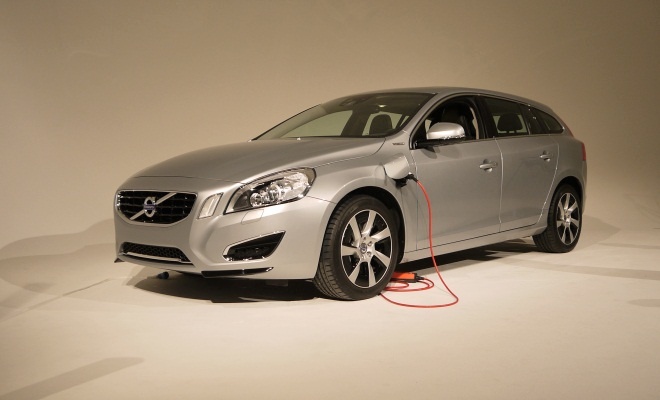
This is the production version of Volvo’s new range-topping V60 estate, which will go on sale late in 2012 priced at about £47,000.
The V60 PHEV (plug-in hybrid electric vehicle) will be able to call on two sources of power: a 215bhp five-cylinder diesel engine in the nose, driving the front wheels, plus a 70bhp electric motor at the back, driving the rear wheels. The combination means the V60 can run in a variety of modes: as a rear-wheel-drive electric car, a front-wheel drive diesel car, or as a four-wheel-drive hybrid. Drivers can call up the various options on demand using a row of buttons on the centre console, or leave the car to make up its own mind as driving conditions dictate.

The electric hardware, including an 11.2kWh lithium-ion battery under the boot floor, weighs a noticeable 300kg – about the same as a family of four. The result is an empty weight nudging uncomfortably close to 2,000kg. Volvo spokespeople mumbled vaguely about still needing to put the car on some scales when I asked for the exact kerb weight, so I guess it may currently be the wrong side of two tonnes.
Despite its heft, the power on tap is sufficient to sling Volvo’s hybrid from rest to 62mph in just 6.2 seconds, quicker than the early estimate of 6.9 seconds. Mind you, drivers will only be able to hit such sports-car heights as long as there is some juice left in the battery, which will disappear all too quickly with too much foot-to-the-floor fun.

As a plug-in hybrid, this V60 will be able to top up its batteries while parked, needing 3.5 hours connected to a 16A, 240V socket to fully recharge from flat – or about half an hour longer from a 13A supply. Like other hybrids, the V60 can also recoup energy while slowing down, using the rear motor as a generator to top up the batteries while braking or descending hills. Volvo quotes an electric-only range of 50km or about 30 miles, and there’s a button to allow the driver to preserve charge for later during a long trip.
The front-to-rear split between conventional and electric drive is still relatively unusual – most hybrids combine two sources of power to drive a single axle. But Volvo is not alone in pursuing the “through the road” hybrid approach, where the asphalt under the wheels provides the link between front and rear propulsion. Peugeot’s Hybrid4 system uses a similar method, although with a much less powerful rear motor.

Volvo has needed to develop fiendishly clever software to seamlessly meld the components of its hybrid into a safe and satisfying whole. The split powertrain offers interesting options: the rear axle can continue to drive while the 6-speed automatic gearbox is busy changing ratios at the front, and four-wheel-drive is useful on slippery surfaces or while towing. But equally, the split setup creates challenges – the rear-biased braking effect of regeneration is potentially dangerous on a high-speed bend, so Volvo has written new stability control software specifically for this car. It will use the front discs to ensure a safe braking balance at all times, according to Volvo’s engineers.
I’ve driven a prototype V60 PHEV and can confirm that Volvo has done a superb job in hiding the joins. The car feels surprisingly fast, agile, stable and responsive.

As well as various plug-in hybrid badges, the V60 PHEV will also wear a new D6 label on its rump. This signifies the increased power over the current beefiest diesel on Volvo’s menu, the D5, which offers the same 2.4-litre engine but without the extra electric power. The new D6 badge is not reserved for hybrids and could appear on conventional diesels with close to 300bhp in the future.
Volvo hopes to sell 4,000 to 6,000 examples of the V60 plug-in hybrid per year, once full production starts in May 2013. The first 1,000 cars, which will be built starting in November 2012, will be sold in a special “Pure Limited” specification, much like the preview example in the pictures. Finished in bright metallic silver with gloss black accessories outside, white-stitched black leather and black wood inside, 17-inch alloys, and lots of toys.

Volvo insiders did let slip that the limited-edition’s colour scheme wasn’t exactly their first choice. Suppliers working on a special finish for the V60 hybrid were hit by the devastating Japanese earthquake and tsunami back in March, delaying work by months. Rather than press ahead with a new paint of unknown durability, Volvo elected for an off-the-shelf silver. It’s a shame – the silk white and pale blue finish of the V60 PHEV prototypes is preferable to shiny silver and black, in my opinion, although the white paint would probably be hell to keep clean.
Volvo hopes to sell about 130 of the initial batch in the UK. Once normal production commences in 2013, prices should fall a little but will probably remain at the top of Volvo’s price list, unless lithium ion batteries undergo an unexpected drop in value. Commercial project leader Johan Rasmusson wouldn’t give me a price for the V60’s battery pack, but said my €5,000 guess was “at the low end” of likely figures. “We are not seeing the decline in lithium ion battery prices predicted a couple of years ago,” he added. “Those savings have simply not materialised.”
Volvo’s V60 plug-in hybrid gears up for launch
13 December 2011
Read more about: electric cars hybrids Volvo



